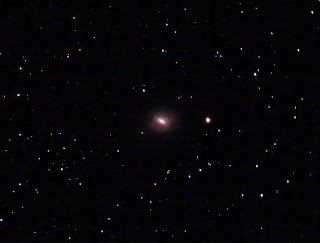M88 (a.k.a. NGC 4501) is a spiral galaxy about 50 to 60 million light-away in the constellation Coma Berenices. It is one of the fifteen Messier objects that belong to the Virgo Cluster of galaxies. Interestingly, M88 seems to be on an elliptical orbit that is carrying it toward the cluster center, which is occupied by the giant elliptical galaxy M87. M91 (a.k.a. NGC 4548 ) is a barred spiral galaxy located also in the Coma Berenices constellation and is about 63 million light-years away from the earth.
Processing theis image proved more difficult as the subtraction method that I have been using on most of the other Virgo galaxies was giving me good results so I went back to Gradient Exterminator to remove the gradients and some of the noise. M88 and M91 represent the 83rd the 84th Messier Object I have captured.
Wide Field
M88-Crop
M91-Crop
M88 and M91Location: Happy Frog Observatory, Monroe, CT
Date: 5-18-17
Camera: Canon EOS Rebel T3i(a), Backyard EOS
Telescope: Orion ED80 80mm f/7.5 Apochromatic Refractor Telescope
Barlow: None
Focal Length: 600mm
f/7.5
Focal Reducer: Orion 0.8x Focal Reducer for Refractor Telescopes
Mount: Orion Sirius EQ-G GoTo Telescope Mount
Filter: Astrodon UV/IR
Autoguiding: QHY-5L-II-M attached to an Agena 50mm Guide Scope with Helical Focuser
Exposure: 60 x 90s
ISO: 1600
Temp: 18 C
Post Processing: Deep Sky Stacker, Photoshop, Lightroom, Gradient Exterminator, Astronomy Tools, StarTools.
https://kurtzeppetello.smugmug.com/




















